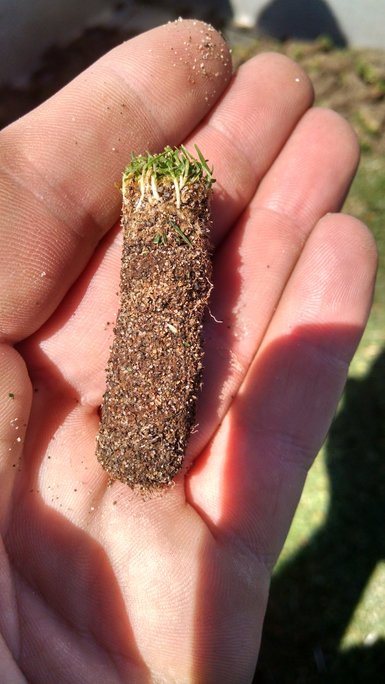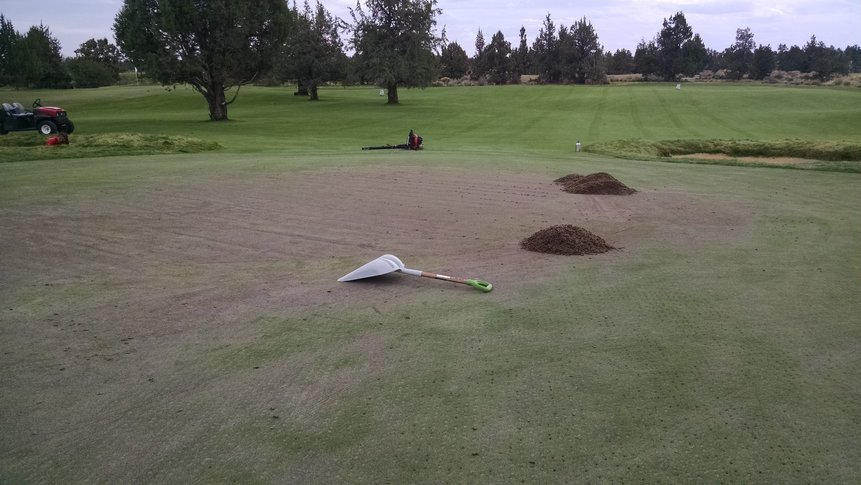Turfgrass aerification can be widely adaptable to the size and type of turfgrass system. Aerification of a home lawn versus a professional sports field or putting green might look a lot different, and that is by design. Higher end facilities might use aerification units that operate in a vertical motion with mechanical arms, whereas homeowner or higher mowed turf might use a rotational based piece of equipment. The tines utilized might also vary greatly. “Pulling cores” is just some of the lingo used in describing the result of hollow tine aerification. This process quite literally pulls a core of soil out of the ground, ejecting it to lay on top of the soil to later be collected or incorporated back into the soil. Solid tine units simply “poke” a hole into the ground, without bringing any plant or organic matter to the surface. Other variables surrounding tines might involve spacing, length, diameter, approach angle, or core ejection methods.

example of a core left behind from hollow tine aerification.
There are some strategies behind choosing to go with hollow tine or solid tine aerification, and ultimately are decided based on the symptoms of a stressed out stand of turfgrass. Both types of aerification open the soil and allow better gas exchange and improve infiltration of water through the soil profile. This action also improves nutrient or amendment access to the plant at lower depths of the soil where it is less likely to be lost to erosion and be better incorporated with the soil profile.
Of the two types, hollow tine aerification will better alleviate compaction in soil as it physically removes material, loosening the profile. Solid tines simply push the soil in multiple directions outwards and downward, compacting soil between tines. Hollow tines also benefit turfgrass health by removing a percentage of organic matter. One should know that cultivation practices like vertical mowing or dethatching may remove more thatch than hollow tine aerification alone, depending on the depth and severity of thatch accumulation.
Aerification is often best performed when turfgrasses are near their peak growth, allowing the grasses to fill in and recover. For cool season grasses this might be in spring and early fall, whereas warm season grasses could be from late spring to early summer. In golf course putting greens and other high priority turfgrass areas this can be a challenge as key stakeholders wish to return to normal use, performance, and visual quality as fast as possible. This often is a concern of turfgrass managers as aerifying deeper into the border seasons can lead to ideal conditions for weed germination and increased turfgrass competition and/or slower recovery.
Another benefit to aerification is allowing for quick access to open soil to aide in successful seeding application. Whether seeding the same species (interseeding) or overseeding another species (overseeding) to improve quality, properly timed aerification can improve seed germination. For cool season species this is often best done in late summer or early fall. At the same time, many turf managers and lawn enthusiasts alike will use this opportunity to apply topdressing (sand or sand-based soils) to fill in the holes and smooth out uneven surfaces.

example of a golf course green after hollow tine aerification before topdressing.
Aerification has many benefits and can greatly improve stressed turfgrass. If you are experiencing compacted turf or your grass’s health has been declining for the past few years, aerification might be right for you, assuming irrigation, fertilization, and mowing are all already in check. This practice might only be required once every 2-3 years for higher mowed turf like home lawns, golf course roughs, or less frequently used sports fields. Increase aerification frequency with higher levels of foot traffic.




